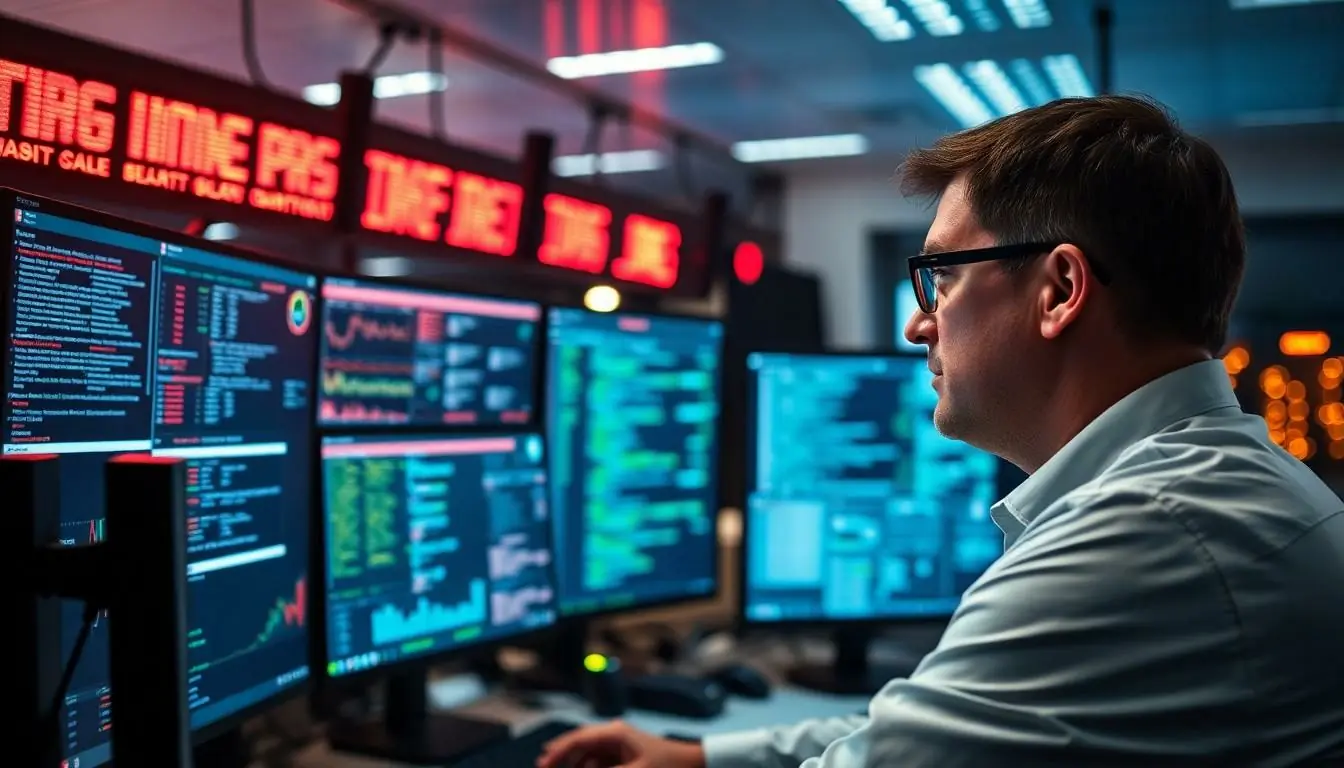In a world where everything from power plants to water treatment facilities relies on industrial control systems, the stakes couldn’t be higher. Cyber threats lurk around every corner, ready to wreak havoc on critical infrastructure. It’s like leaving the front door wide open while inviting hackers in for tea.
But fear not! Understanding industrial control systems cyber security is more important than ever. With the right strategies and a dash of humor, organizations can fortify their defenses and keep those pesky cyber intruders at bay. After all, no one wants to be the punchline in a cyber attack joke. Buckle up as we dive into the quirky yet crucial world of securing industrial control systems, ensuring safety and reliability in our increasingly interconnected lives.
Table of Contents
ToggleOverview of Industrial Control Systems Cyber Security
Industrial control systems (ICS) are vital for managing critical infrastructure. These systems integrate various technologies, from hardware to software, to control processes such as power distribution and water purification. Cyber threats pose a significant risk, targeting these systems to disrupt services or cause damage.
Various types of risks affect ICS, including malware, phishing attacks, and insider threats. Malware specifically designed for ICS can disrupt operations or compromise sensitive data. Phishing attacks often trick personnel into providing access to secure systems. Insider threats may come from disgruntled employees or contractors who exploit their knowledge to harm the organization.
Organizations must implement robust strategies to safeguard their ICS. Security patches should be regularly applied to prevent exploitation of known vulnerabilities. Network segmentation can limit access and protect critical components from broader network threats. Regular audits and monitoring are essential to detect anomalies early.
Training programs for employees also play a crucial role in raising awareness about cyber risks. Staff must understand the importance of maintaining security protocols and recognizing suspicious activities. Engaging in these best practices fosters a culture of security throughout the organization.
Collaboration with cybersecurity experts can bolster defenses. Consulting with specialists provides insights into industry-specific threats and defenses. Adopting a proactive approach ensures organizations stay ahead of potential vulnerabilities.
Securing industrial control systems is an ongoing effort. Companies must prioritize cybersecurity measures to maintain functionality and protect infrastructure. By addressing identified risks through coordinated strategies, organizations can improve their resilience against cyber attacks.
Key Threats to Industrial Control Systems

Cyber threats to industrial control systems (ICS) present significant challenges for organizations. Understanding these threats is critical for developing effective security measures.
Types of Cyber Attacks
Malware tops the list of attacks targeting ICS. This software can disrupt operations and cause substantial damage. Phishing attacks, often used to gain unauthorized access, trick users into revealing sensitive information. Insider threats pose risks from employees or contractors who misuse their access. Distributed denial-of-service (DDoS) attacks overload systems and disrupt services, affecting production processes. Other methods such as ransomware can lock critical systems, demanding payment for release.
Emerging Threats in the Landscape
Emerging threats continually reshape the cyber landscape. Advanced persistent threats feature attackers who maintain a long-term presence within a network, aiming for strategic sabotage. Supply chain attacks exploit vulnerabilities in third-party vendors to compromise ICS. Zero-day vulnerabilities attract attention as hackers exploit unknown weaknesses before patches release. Additionally, the rise of Internet of Things devices introduces new entry points for cybercriminals. Each of these threats raises the urgency for organizations to enhance their cybersecurity strategies and defenses.
Best Practices for Securing Industrial Control Systems
Securing industrial control systems (ICS) demands a strategic approach. Adopting effective practices not only enhances safety but ensures operational continuity.
Risk Assessment Strategies
Conducting regular risk assessments identifies vulnerabilities within ICS. Organizations evaluate the potential impact of various cyber threats on their systems. Prioritizing assets helps resources focus on the most critical areas of risk. Utilizing specialized tools assists in analyzing security posture and threat landscapes. Engaging stakeholders during assessments fosters a comprehensive understanding of risks. Continuous monitoring of threats supports timely updates to safeguards.
Implementing Security Measures
Applying security measures strengthens ICS defenses against cyber threats. Start with network segmentation to isolate critical systems from less secure environments. Regularly updating software and applying security patches addresses known vulnerabilities. Employing firewalls and intrusion detection systems adds layers of protection. Strong authentication methods ensure only authorized personnel access sensitive data. Training employees fosters a security-aware culture, empowering them to detect and respond to threats effectively.
Regulatory Framework and Standards
Cybersecurity for industrial control systems operates within a complex regulatory and standards landscape. Compliance with relevant regulations ensures enhanced security measures and promotes best practices across the industry.
Key Regulations Impacting Industrial Control Security
Several key regulations impact industrial control security. The National Institute of Standards and Technology (NIST) framework emphasizes risk management and provides guidelines for managing cybersecurity risks. The North American Electric Reliability Corporation (NERC) enforces stringent reliability standards for electrical grids, focusing on critical infrastructure protection. In addition, the Federal Energy Regulatory Commission (FERC) mandates compliance with these standards to maintain system integrity. Organizations involved in industrial control must prioritize adherence to these regulations to mitigate risks effectively.
Industry Standards for Best Practices
Industry standards serve as benchmarks for best practices in cybersecurity. The International Organization for Standardization (ISO) offers a comprehensive standard, ISO/IEC 27001, guiding organizations in establishing, implementing, and maintaining information security management systems. The International Society of Automation (ISA) similarly provides the ISA/IEC 62443 series, which focuses on securing industrial automation and control systems. Additionally, frameworks like the Cybersecurity Framework from NIST encourage organizations to engage in proactive risk management. Utilizing these standards helps organizations enhance their cybersecurity posture and ensure ongoing protection against evolving threats.
Future Trends in Industrial Control Systems Cyber Security
Emerging technologies are reshaping cybersecurity within industrial control systems (ICS). Increased adoption of artificial intelligence enhances threat detection and response capabilities. Quantum computing is poised to revolutionize encryption, necessitating a reevaluation of existing security protocols.
Adoption of the Internet of Things (IoT) continues to expand, introducing new vulnerabilities. Organizations must identify and mitigate risks associated with interconnected devices. As these devices proliferate, securing their communication channels becomes imperative.
Regulatory compliance will likely evolve to address evolving threats. Standards from entities such as the National Institute of Standards and Technology (NIST) and the North American Electric Reliability Corporation (NERC) will adapt to reflect new security landscapes. Organizations staying ahead of these changes exhibit proactive strategies for safeguarding their systems.
Collaboration with cybersecurity experts is increasingly essential. Organizations tapping into the expertise of these professionals strengthen their defenses. Sharing threat intelligence among industry peers fosters a robust security environment that benefits all.
Risk assessments will focus more on continuous monitoring. This shift allows for timely identification of vulnerabilities and immediate responses. Enhanced situational awareness will aid organizations in anticipating and mitigating potential threats.
Employee training will shift to include hands-on simulation exercises. Engaging staff in realistic scenarios cultivates a culture of preparedness. A workforce well-versed in cybersecurity practices plays a pivotal role in maintaining operational integrity.
Investment in cybersecurity technologies will likely rise. As threats evolve, organizations realize the significance of robust security measures. Allocating resources to security initiatives often translates to improved resilience against attacks.
Securing industrial control systems is a vital endeavor that demands ongoing attention and proactive strategies. As cyber threats continue to evolve organizations must prioritize robust defenses and compliance with industry standards. By implementing best practices such as regular risk assessments employee training and collaboration with cybersecurity experts organizations can significantly enhance their resilience.
The integration of emerging technologies like artificial intelligence and the focus on continuous monitoring will further shape the landscape of ICS cybersecurity. As the interconnectedness of systems grows so does the need for a comprehensive approach to security. A commitment to these principles will ensure the safety and reliability of critical infrastructure in an increasingly digital world.

